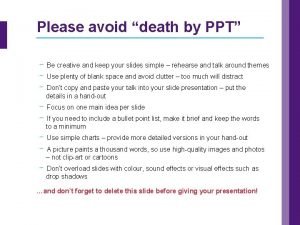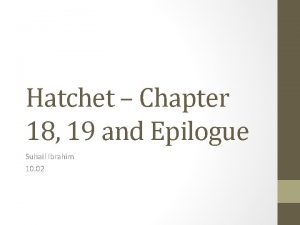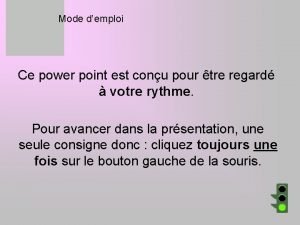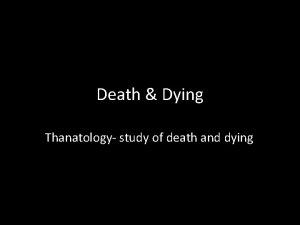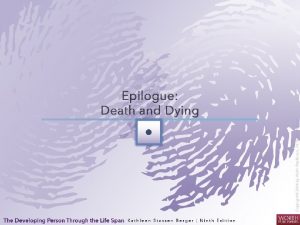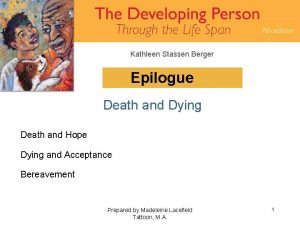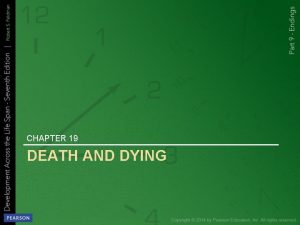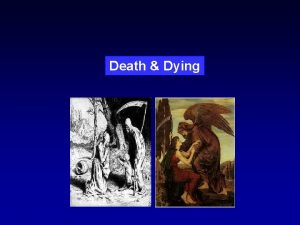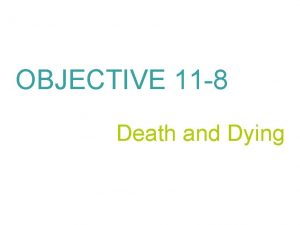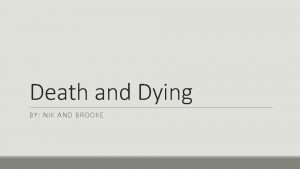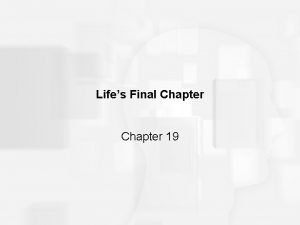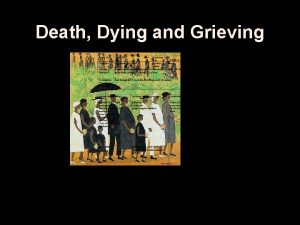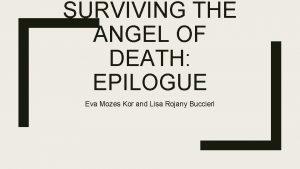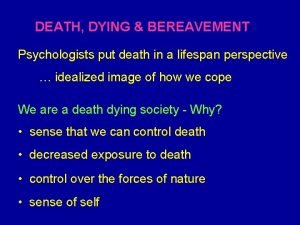Death Dying Epilogue Death and Dying Thanatology The





















- Slides: 21

Death & Dying Epilogue

Death and Dying Thanatology • The study of death and dying – Especially the social and emotional aspects. – Neither morbid or gloomy, it reveals: • The reality of hope in death • Acceptance of dying • Reaffirmation of life

Death and Hope

Dealing with death at different ages � How do young children deal with death? Infants? ◦ Different conception of time. ◦ Some research suggests that children do not typically see death as universal and permanent until around 9. (Cuddy-Casey & Orvaschel, 1997).

Adolescents and death � Adolescents may tend to treat death and aging as remote, unless it is brought to the forefront of their attention. � They develop more abstract notions of death than we see in children. (Wennestam & Wass, 1987) � In cases of peer suicide, adolescents will often express guilt that they were not able to stop it, feelings that they should have died, and feelings of rejection by others friends who hold them responsible. (Hayslip & Hansson, 2003)

Adults and death � Consciousness of death is most intense during middle-adulthood. � They fear death more that young or old adults. ◦ Why? � Young adults often feel more cheated when dying than older adults. (Kalish & Reynolds, 1976; Hayslip & Hansson, 2003; Kalish, 1987)

Attending to the Needs of the Dying Kübler-Ross identified emotions experienced by dying people, which she divided into five stages: 1. Denial (“I am not really dying. ”) 2. Anger (“I blame my doctors, or my family, or God for my death. ”) 3. Bargaining (“I will be good from now on if I can live. ”) 4. Depression (“I don’t care about anything; nothing matters anymore. ”) 5. Acceptance (“I accept my death as part of life. ”)

Evaluation of Kubler-Ross � 5 -stage sequence has not been supported by research findings � Stages did not account for individual circumstances of patient and support systems � However, she did much to call attention to the issues of quality of life and coping with dying.

Coping with Death and Loss � It is best for dying persons and their family members to know that death is immanent and a reality ◦ individuals can close life with their own ideas about proper dying ◦ they can complete some projects and plans and can make arrangements for funeral and for survivors ◦ can reminisce (Banja, 2005) (Kalish, 1981)

Effective Strategies for Communicating with a Dying Person � Establish presence at same eye level and don’t be afraid to touch the dying person � Eliminate distraction, including excessive small talk � Keep visits short with frail individuals � Don’t prescribe or deny feelings of acceptance � Allow and encourage expressions of feeling

� Ask the person what the expected outcome of the illness is; discuss alternatives and unfinished business � Ask if there is anyone he or she would like to see or have someone contact � Encourage reminiscences � Talk to the individual when he or she wishes to talk � Express your regard for the dying individual, don’t be afraid to express love

Religions and Hope � People who think they might die soon are more likely than others to believe in life after death. � Virtually every world religion provides rites and customs to honor the dead and comfort the living. � Although not everyone observes religious customs, those who care for the dying and their families need extraordinary sensitivity to cultural traditions.

Near-Death Experience • An episode in which a person comes close to dying but survives and reports having left his or her body and having moved toward a bright white light while feeling peacefulness and joy. • Near-death experiences often include religious elements. • Survivors often adopt a more spiritual, less materialistic view of life.

Palliative Medicine � Palliative care ◦ Care designed not to treat an illness but to provide physical and emotional comfort to the patient and support and guidance to his or her family. � Double effect ◦ An ethical situation in which an action (such as administering opiates) has both a positive effect (relieving a terminally ill person’s pain) and a negative effect (hastening death by suppressing respiration).

Hastening or Postponing Death � Passive euthanasia ◦ A situation in which a seriously ill person is allowed to die naturally, through the cessation of medical intervention. � DNR (do not resuscitate) ◦ A written order from a physician (sometimes initiated by a patient’s advance directive or by a health care proxy’s request) that no attempt should be made to revive a patient during cardiac or respiratory arrest.

Hastening or Postponing Death � Active euthanasia ◦ A situation in which someone takes action to bring about another person’s death, with the intention of ending that person’s suffering. ◦ Legal under some circumstances in the Netherlands, Belgium, Luxembourg, and Switzerland, but it is illegal (yet rarely prosecuted) in most other nations. � Physician-assisted suicide ◦ A form of active euthanasia in which a doctor provides the means for someone to end his or her own life.

When Physician-Assisted Suicide Is Legal

Advance Directives � An individual’s instructions for end-of-life medical care, written before such care is needed. � Living will ◦ A document that indicates what kinds of medical intervention an individual wants or does not want if he or she becomes incapable of expressing those wishes. � Health care proxy ◦ A person chosen by another person to make medical decisions if the second person becomes unable to do so.

Bereavement Normal Grief � Bereavement ◦ The sense of loss following a death. � Grief ◦ The powerful sorrow that an individual feels at the death of another. � Mourning ◦ The ceremonies and behaviors that a religion or culture prescribes for people to employ in expressing their bereavement after a death.

Complicated Grief � Grief that impedes a person’s future life � Absent grief ◦ A situation in which overly private people cut themselves off from the community and customs that allow and expect grief; can lead to social isolation. � Disenfranchised grief ◦ A situation in which certain people, although they are bereaved, are prevented from mourning publicly by cultural customs or social restrictions.

Mourning That Does Not Heal Incomplete grief • A situation in which circumstances, such as a police investigation or an autopsy, interfere with the process of grieving. • The grief process may be incomplete if mourning is cut short or if other people are distracted from their role in recovery.
 Thanatology ppt
Thanatology ppt Pathological condition
Pathological condition Decremental model of aging
Decremental model of aging Thanatology adalah
Thanatology adalah Hatchet chapter 18 summary
Hatchet chapter 18 summary The crucible epilogue
The crucible epilogue Epilogue the wife of noble character
Epilogue the wife of noble character What happened at the battle of marathon
What happened at the battle of marathon Why was the watsons go to birmingham banned
Why was the watsons go to birmingham banned Tpn epilogue
Tpn epilogue Midata mss
Midata mss Apostrophe figure of speech definition and examples
Apostrophe figure of speech definition and examples Chapter 23 dying death and hospice
Chapter 23 dying death and hospice Chapter 13 - death and dying
Chapter 13 - death and dying James hurst writer
James hurst writer Somatic and molecular death
Somatic and molecular death Hát kết hợp bộ gõ cơ thể
Hát kết hợp bộ gõ cơ thể Ng-html
Ng-html Bổ thể
Bổ thể Tỉ lệ cơ thể trẻ em
Tỉ lệ cơ thể trẻ em Voi kéo gỗ như thế nào
Voi kéo gỗ như thế nào Glasgow thang điểm
Glasgow thang điểm
